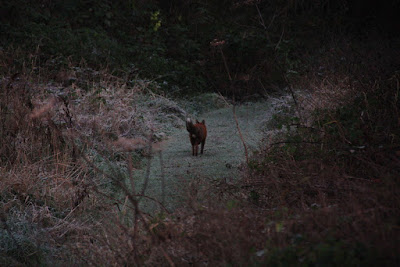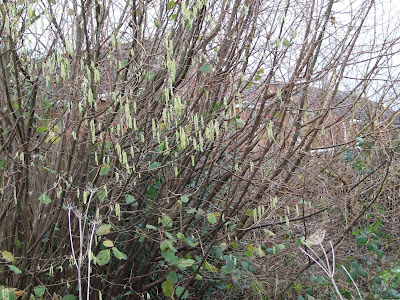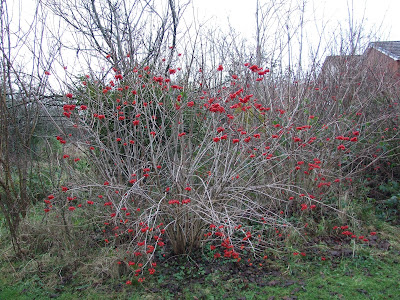 |
| Snow on Cleaver Heath |
Finally, in January, we had a smattering of snow on Cleaver giving the place a more wintery look.
 |
| Bilberry (left) planted in an area which has been cleared of bracken (right) |
It has been Covid rather than the weather that has complicated the traditional routine of monthly work days this year. Nevertheless, we have managed to get through much of what we had planned in terms of birch and gorse control within the heather panels and managing the scrub areas. The latter are held in check by coppicing where we cut back the larger of the birch saplings which are trying to develop into full-grown trees. Likewise, we cut back the older European gorse in scrub areas to keep the plants dense and hence of more value to wildlife. Where the gorse on the edge encroaches and shades the heather, we treat the gorse stumps after cutting to prevent/reduce re-growth. Actually, within the managed scrub area, we have a beautiful and expanding group of Bilberry plants. Following a suggestion from our Trust manager, we have used some of the Bilberry shoots starting to move into the main footpath to populate an area we have recently cleared of bracken. This area at the edge of a main heather panel, had suffered from excess footfall by people going off-piste, soil enrichment mainly due to dogs and recolonization by bracken. We think of this as a mini heathland restoration project. The temporary sign put up after our January work day explains what is happening and almost every new person walking past stops to read it!
 |
| Green woodpecker |
In
recent weeks there has been quite a lot of Green Woodpecker activity – mainly I
hear the calls of a male but just occasionally it perches up on a birch tree so
I can get a look at it. Here is a photo of a male taken last year by local
resident Frank Burns. I don’t know if it is the same male, but it is on the
same pine tree featuring in the above photo of the re-planted Bilberry. As well as the various tit flocks moving
around the reserve, I have been lucky enough to come across the odd Goldcrest
whose numbers on Wirral this winter seem to be
pretty good.
 |
| Goldcrest |
When compiling the results of the recent botanical survey of Heswall Dales, we came across a vegetation map of Heswall Dales from, we think, 1980. The areas classified as heather, scrub and birch seem remarkably similar to those identified in 2020 contrary to what local critics may suggest. The birch trees are of course a lot taller now. That got me thinking about what was the corresponding state of ‘The Dales’ in that part now known as Cleaver Heath? So, I tried to dig out photos from when we first moved in during October 1976.
 |
| The area now known as Cleaver Heath in 1976 |
This first photo was taken in December 1976. The figure, included to provide scale and who is sticking nicely to the path, was 2 years old and proudly exhibiting her mother’s sewing and knitting skills. There is little sign of the large birch and gorse stands now present and obscuring the houses.
 |
| The area now known as Cleaver Heath in 1976 |
The next photo, showing the future volunteer warden’s house, was taken from what we have now earmarked as a potential area for heathland restoration. Clearly bracken was already a problem, but we only see modest amounts of gorse or birch in the area now designated as ‘managed scrub’. I don’t recall any evidence of heathland management ever being carried out by the hospital ‘gardeners’. That only started when Cheshire Wildlife Trust bought and managed the land in the 1990s so I remain puzzled by this.
 |
| Flooding at Cleaver Heath |
Recent visitors to the reserve have needed wellies following the efforts of storm Christoph and his accomplices. I have never before seen such flooding throughout the reserve. The good news is that the main heathland path which we stoned a couple of years ago has stood up well but will soon need reinforcing if we are to avoid further heather damage as people divert to protect inappropriate footwear.
 |
| Winter sunset from Cleaver Heath |
On better afternoons, the sunsets over the Dee have been up to their usual winter standard and provided a suitable reward for the many visitors currently taking their exercise here.
 |
| Reserve entrance at Cleaver Heath |
My usual ‘seasonally-adjusted’ photo of the reserve entrance has benefitted from the earlier brief snowfall. Perhaps we might get another ‘Beast-from-the East’ to feature in my corresponding spring photo.
Alan Irving
Volunteer Reserve Warden for CWT
Cleaver Heath
January 2021






